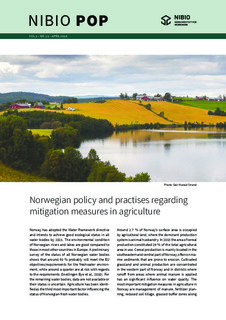| dc.contributor.author | Greipsland, Inga | |
| dc.date.accessioned | 2016-04-27T08:45:39Z | |
| dc.date.accessioned | 2016-04-27T09:35:24Z | |
| dc.date.available | 2016-04-27T08:45:39Z | |
| dc.date.available | 2016-04-27T09:35:24Z | |
| dc.date.issued | 2016 | |
| dc.identifier.isbn | 978-82-17-01630-4 | |
| dc.identifier.uri | http://hdl.handle.net/11250/2387569 | |
| dc.description.abstract | Norway has adopted the Water Framework directive and intends to achieve good ecological status in all water bodies by 2021. The environmental condition of Norwegian rivers and lakes are good compared to those in most other countries in Europe. A preliminary survey of the status of all Norwegian water bodies shows that around 50 % probably will meet the EU objectives/requirements for the freshwater environment, while around a quarter are at risk with regards to the requirements (Snellingen Bye et al., 2010). For the remaining water bodies, data are not available or their status is uncertain. Agriculture has been identified as the third most important factor influencing the status of Norwegian fresh water bodies. | |
| dc.language.iso | eng | |
| dc.relation.ispartofseries | NIBIO POP;2(21) 2016 | |
| dc.title | Norwegian policy and practises regarding mitigation measures in agriculture | |
| dc.type | Others | |
| dc.date.updated | 2016-04-27T08:45:39Z | |
| dc.subject.nsi | VDP::Landbruks- og fiskerifag: 900::Landbruksfag: 910::Naturressursforvaltning: 914 | |
| dc.subject.nsi | VDP::Agriculture and fisheries science: 900::Agricultural sciences: 910::Natural resource management: 914 | |
| dc.identifier.cristin | 1484291 | |
| dc.subject.keyword | Erosjon og vannkvalitet / Erosion and water quality | |
| dc.subject.keyword | Jordbruk / Agriculture | |
| dc.subject.keyword | Vannkvalitet / Water quality | |
